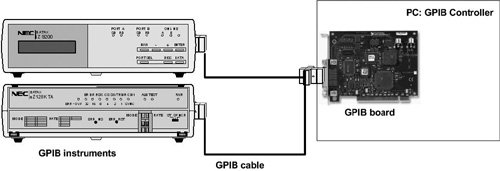What Is GPIB?
| Hewlett Packard developed the General Purpose Interface Bus, or GPIB, in the late 1960s to facilitate communication between computers and instruments. A bus is simply the means by which computers and instruments transfer data, and GPIB provided a much-needed specification and protocol to govern this communication. The Institute of Electrical and Electronic Engineers (IEEE) standardized GPIB in 1975, and it became known as the IEEE 488 standard (GPIB = IEEE 488). GPIB's original purpose was to provide computer control of test and measurement instruments. However, its use has expanded beyond these applications into other areas, such as computer-to-computer communication and control of multimeters, scanners, and oscilloscopes. GPIB is a parallel bus that many instruments use for communication. GPIB sends data in bytes (one byte = eight bits), and the messages transferred are frequently encoded as ASCII character strings. Your computer can only perform GPIB communication if it has a GPIB board (or external GPIB box), such as those shown in Figure 2.3, and the proper drivers installed. Figure 2.3. GPIB boards from NI You can have many instruments and computers connected to the same GPIB bus. Every device, including the computer interface board, must have a unique GPIB address between 0 and 30, so that the data source and destinations can be specified by this number. Address 0 is normally assigned to the GPIB interface board. Instruments connected to the bus can use addresses 1 through 30. The GPIB has one Controller, usually your computer, that controls the bus management functions. To transfer instrument commands and data on the bus, the Controller addresses one Talker and one or more Listeners. The data strings are then sent across the bus from the Talker to the Listener(s). The LabVIEW GPIB VIs automatically handle the addressing and most other bus management functions, saving you the hassle of low-level programming. The following illustration shows a typical GPIB system (see Figure 2.4). Figure 2.4. Typical GPIB system containing one or more GPIB enabled instruments and a GPIB controller board Although using GPIB is one way to bring data into a computer, it is fundamentally different from performing data acquisition, even though both use boards that plug into the computer. Using a special protocol, GPIB talks to another computer or instrument to bring in data acquired by that device, while data acquisition involves connecting a signal directly up to a computer's DAQ device. To use GPIB as part of your virtual instrumentation system, you need a GPIB board or external box, a GPIB cable, LabVIEW and a computer, and an IEEE 488-compatible instrument with which to communicate (or another computer containing a GPIB board). You also need to install the GPIB driver software on your computer as well, according to the directions that accompany LabVIEW or the board.
LabVIEW's GPIB VIs communicate with National Instruments' GPIB boards, but not those from other manufacturers. If you have another vendor's board, you can either get driver software from them (if it's available) or write your own driver code and integrate it into LabVIEW. As with DAQ drivers, it's not an easy thing to do! We'll talk more about DAQ and GPIB in Chapters 10, "Signal Measurement and Generation: Data Acquisition," 11, "Data Acquisition in LabVIEW," and 12, "Instrument Control in LabVIEW." |
EAN: 2147483647
Pages: 294

